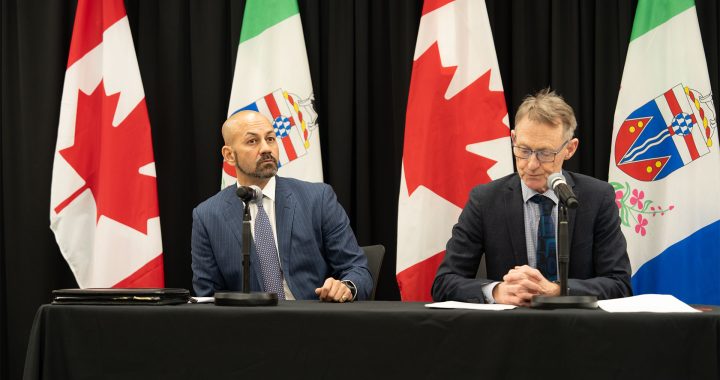(Preceding photo believed to be of Klatsassin, war chief of Tsilhqot’in, played a lead role in the Chilcotin War of 1864. His name means, “We do not know his name.”)
By Jorge Barrera
APTN National News
Resistance to a planned gold and copper mine in British Columbia’s interior echoes another conflict for the Tsilhqot’in people who are leading the fight to have the project stopped.
It was a conflict that ended with the death of at least 19 European settlers and the hanging of six Tsilhqot’in chiefs.
And like the Chilcotin War of 1864, the current battle with the planned Prosperty mine is over gold, says Xeni Gwet’in Chief Marilyn Baptiste, whose community is one of six that make up the Tsilhqot’in nation.
“Our war leaders of 1864 were protecting and saving our land, our title, our rights, our fish and our waters,” said Baptiste. “Back then and now again, they are after gold.”
Baptiste invoked the legacy of the Chilcotin War this week during a press conference in Ottawa while explaining the depth of opposition to the mine in her community.
She said that many Tsilhqot’in people would sacrifice their lives to stop the Taseko-owned mine.
The mine, which is expected to produce about $3 billion worth of gold and copper, would lead to the draining of a lake sacred to the Tsilhqot’in people.
“Our war leaders, many generations ago, protected what we are protecting now and if it were not for them we would not be who we are,” said Baptiste.
The mine, which has an expected lifespan of 33 years, has been approved by the B.C. government and now needs only the go-ahead from Prime Minister Stephen Harper’s cabinet to become a reality.
The project, however, took a major blow this summer when a Canadian Environmental Review Agency panel found the mine would have a detrimental impact on the ecosystem and on First Nations communities who have lived in the region since time immemorial.
The 35 square-kilometre mine would see the draining of rainbow trout-abundant Fish Lake which would be turned into a waste rock and low grade ore storage area.
Nearby Little Fish Lake and parts of Fish Creek would also be destroyed and turned into a tailings pond.
Taseko has pledged to build a replacement lake named Prosperity Lake to be stocked with replacement fish.
The panel’s report will be one of several issues weighed by the federal cabinet in its decision on the future of the mine, which would sit about 125 kilometres southwest of Williams Lake, B.C. Williams Lake is about 495 kilometres north-east of Vancouver.
When asked in Iqaluit this week for his views on the project and the position of the Tsilhqot’in, newly appointed Indian Affairs Minister John Duncan said cabinet confidentiality prevented him from commenting.
“The project is subject to a cabinet consideration at this point and there’s cabinet confidentiality that floats around,” said Duncan. “We’ll know what the result of the process is when it’s announced and before that I’m really not in a position to be able to say anything.”
Local Conservative MP Dick Harris has been vocal in his support of the mine and told local newspaper Williams Lake Tribune that the prime minister was “acutely aware of the importance” of the project to the local economy.
Baptiste, however, said no amount of revenue would compensate for the destruction of an area described as “pristine” by the federal panel.
“We are people connected to the land and the land is connected to us,” she said. “Our wild trout, our wild fish, our wild game that provides for our people as well as the berries and the medicine on our land, you cannot erase those things in our lives and replace it with crackers and soup mix.”
Baptiste said the mine threatens to destroy an integral part of her people and its planned development is similar to what the Tsilhqot’in faced in the mid-1800s.
Back then they faced a planned toll wagon road aimed at connecting the nascent colony’s Pacific coast through Bute Inlet to the newly discovered gold fields of Williams Creek, in the interior.
The project threatened to upend the already besieged Tsilhqot’in people facing their first major outbreak of smallpox, spread in large part by infected blankets sold by traders.
“These white people, they bring blankets from people who die of smallpox,” said former Tsilhqot’in chief Henry Solomon, in an oral account of the small pox outbreak contained in a book called Nemiah: The unconquered country, by Terry Glavine.
“Then he wrap them up and he sell them to these Indians, then the Indian, he didn’t know, he just sleep on it, them blankets. Pretty soon he got them sickness, and pretty soon the whole camp got it. So pretty soon my grandmother and his sister, they’re the only one that survive.”
Baptiste said the road plans worried Tsilhqot’in leaders at the time.
“Our chiefs and our leaders back then were well aware that if we allowed those people coming through our territory after the gold . . . that they would destroy our fish, our waters,” she said.
The road work began to cause friction with the Tsilhqot’in, even though some found jobs with the work crews.
There were incidents of road workers raping Tsilhqot’in girls. The Tsilhqot’in who worked with the crews were mistreated and denied food.
Then, in the spring of 1864, four bags of flour were stolen from a road crew’s base camp. The crew’s foreman threatened the Tsilhqot’in with smallpox for stealing.
Journalist Melvin Rothenburger, who wrote a book called the The Chilcotin War, believes this threat may have helped spark the war.
“That could have been an important factor because of the fear of smallpox and it had been rampant,” said Rothenburger, whose great-great grandfather Donald McLean was killed in the ensuing battles with the Tsilhqot’in.
News of the smallpox threat and rapes stirred a group of Tsiloqot’in to launch what turned into a guerilla war against the settlers. Of this group, a war chief known as Klatsassin or Lhatasassine, meaning “We do not know his name,” came to embody the Chilcotin War.
They fired their first shot on the morning of April 28, 1864. It killed a ferryman who refused Klatsassin and his party passage.
The next morning, at daybreak, Klatsassin and his war party descended on the main work crew camp. The cook, tending the fire, was the first to be cut down by gunfire. The Tsilhqot’in then severed the ropes of the tents, shooting and stabbing nine of the crew members to death.
Three managed to escape.
The war party then moved to another camp. There, the foreman who issued the smallpox threat was killed along with three other men.
The Tsilhqot’in used their knowledge of the rugged terrain to their advantage, setting traps, launching ambushes and eluding colonial parties for weeks that had been sent into the bush to track them down.
Rothenburger’s greath-great grandfather McLean met his death after falling into a trap set by the Tsilhqot’in. McLean followed a trail of wood shavings carved by the Tsilhoqot’in that led to an ambush. McLean, known to the Tsilhqot’in as Samandlin, wore a breast plate for protection, said Rothenburger.
“The Tsilhqot’in knew about this and set it up so they could get behind him,” said Rothenburger.
With the colony ramping up efforts against the guerillas, the Tsilhqot’in sought to negotiate peace. Believing they had been granted immunity, Klatsassin and a group of chiefs travelled to meet with Frederick Seymour, then the governor of the colony of British Columbia.
They were shackled in their sleep and taken prisoner. Klatsassin and four others were convicted of murder. They were hung at 7 a.m. in what is now Quesnel, B.C., on Oct. 26, 1864.
Before he died Klatsassin famously said, “We meant war, not murder.”
Two other Tsilhqot’in men also turned themselves in, offering to pay compensation for what they did. They were also arrested and sentenced to death. One managed to escape, but the other man named Ahan, was hung in New Westminster on July 18, 1865
To this day, the Tsilhqot’in are still trying to recover his remains.
In 1993, the judge in charge of the Cariboo-Chilcotin Justice Inquiry examining the relationship between First Nations and the B.C. justice system recommended the provincial government give the Tsilhqot’in chiefs a pardon.
“There was genuine concern that the chiefs were induced to surrender and give inculpatory statements on a promise of immunity. . . Many natives still feel that the trial and hangings were more a showpiece to impress the natives than an honest search for truth,” wrote Judge Anthony Sarich. “That episode in history has left a wound in the body of Chilcotin society. It is time to heal that wound.”
The provincial government apologized for the hangings in 1999.
Baptiste said the guerrilla war launched by Klatsassin had a lasting impact on her community. She believes the legacy of the war protected Xeni Gwet’in, a community of about 400 people which sits about 250 kilometres west of Williams Lake, from serious encroachment.
A highway did not link to her community until the early 1970s and they have chosen to stay off the BC Hydro electrical grid, generating their own power instead through a mix of generators, solar and hybrid system using propane and solar energy.
“We have never signed a treaty and we never will,” she said.










hmmm wonder if there was a land claim, if there wasn’t, then the feds do not and cannot touch this lake.